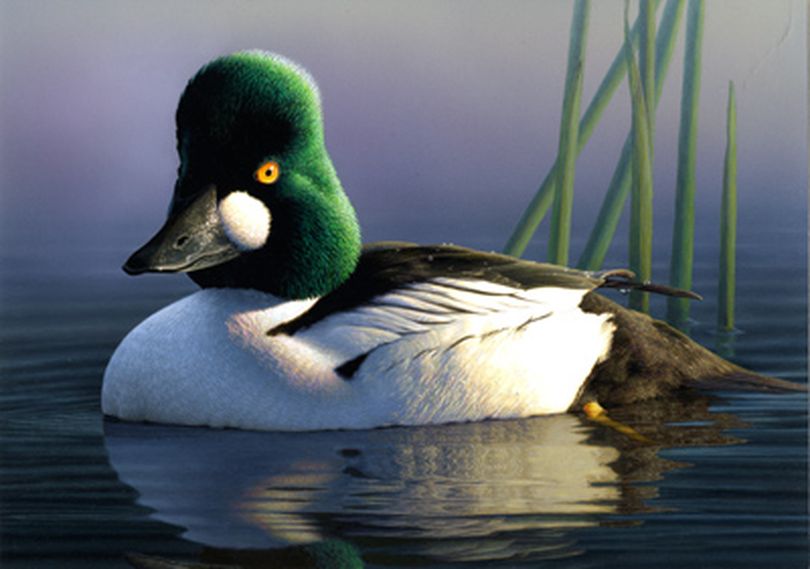California artists wins 2012 Duck Stamp Contest

CONSERVATION -- An image of a common goldeneye painted with uncommon talent by Robert Steiner, an artist from San Francisco, Calif., is the winner of the 2012 Federal Duck Stamp Art Contest.
The artwork will be featured on the 80th federal migratory bird stamp, which will be purchased by collectors, waterfowlers and other wetlands conservationists next year.
The announcement was made today by U.S. Fish and Wildlife Service Deputy Director Rowan Gould at Weber State University in Ogden, Utah, during the annual art contest – the only juried art competition sponsored by the federal government.
This is Steiner’s second Federal Duck Stamp Contest win. His art previously appeared on the 1998-1999 Federal Duck Stamp.
Steiner’s acrylic painting of a common goldeneye will be made into the 2013-2014 Federal Duck Stamp, which will go on sale in late June 2013. The Service produces the Federal Duck Stamp, which sells for $15 and raises about $25 million each year to provide critical funds to conserve and protect wetland habitats in the National Wildlife Refuge system for the benefit of wildlife and the enjoyment of people.
Read on for more details.
Of 192 entries in this year’s two-day competition, 17 entries made it through to the final round of judging. Paul Bridgeford of Des Moines, Iowa, placed second with his acrylic painting of a pair of northern shovelers.
"I congratulate Robert Steiner on his second Federal Duck Stamp Contest win, and my appreciation goes out to all of the artists who entered the contest this year,” said Gould. “I look forward to seeing this beautiful artwork adorning the 80th Federal Duck Stamp – one of our nation’s oldest and most successful conservation programs – when it goes on sale next June.”
“Whether you buy a Duck Stamp to hunt waterfowl, add to your stamp collection, admire in a frame, or contribute to conservation, you are buying a piece of history,” said Jerome Ford, the Service’s Assistant Director for Migratory Birds. “For nearly 80 years, hunters, wildlife watchers, and millions of other people who purchase Federal Duck Stamps have made a direct contribution to wildlife conservation through the protection of wetland habitats.”
Waterfowl hunters age 16 and older are required to purchase and carry the current Migratory Bird Conservation and Hunting Stamp – commonly known as the Duck Stamp. Conservationists, stamp collectors and others may also purchase the stamp in support of habitat conservation. A current Duck Stamp can also be used for free admission to any National Wildlife Refuge open to the public. Refuges offer unparalleled recreational opportunities, including hunting, fishing, bird watching, and photography.
Ninety-eight percent of the proceeds from sale of the $15 Federal Duck Stamp go to the Migratory Bird Conservation Fund, which supports the purchase of migratory bird habitat for inclusion into the National Wildlife Refuge System. Since 1934, Federal Duck Stamp sales have raised more than $850 million, helping the Service purchase or lease 6 million acres of wildlife habitat on hundreds of Refuges in nearly every state. There are 560 National Wildlife Refuges spread across the 50 states and U.S. territories.
Wetlands serve a number of important functions and provide benefits to humans and wildlife. Many species are dependent upon wetlands for all or a portion of their life cycles. For people, wetlands support vegetation that acts as a flood buffer and reduces stream bank erosion during floods. Wetlands improve water quality by filtering polluted runoff from cities and agricultural lands, and provide recharge to aquifers. Finally, wetlands serve for recreational purposes such as hiking, bird watching, wildlife photography, and hunting. These activities bring tourism dollars into rural communities in the U.S. and provide critical support to local economies.
Buy Federal Duck Stamps at many national wildlife refuges, the U.S. Postal Service, or online.
